
Brayley is a lunar impact crater located in the southwest part of the Mare Imbrium. It was named after British geographer Edward W. Brayley in 1935. It has a circular rim and a low rise in the center. There are no notable craters overlapping the rim or interior. The sinuous rille Rima Brayley passes to the north of Brayley.

Bobillier is a tiny, cup-shaped lunar impact crater in the southwest part of Mare Serenitatis. It was named after French geometer Étienne Bobillier in 1976. It lies to the north-northwest of the crater Bessel. To the south and west is a wrinkle ridge designated Dorsum Buckland. Bobillier was previously identified as Bessel E.

Ching-Te is a small lunar impact crater located in a mountainous area to the east of the Mare Serenitatis. It is a circular, bowl-shaped formation with no distinguishing features.

Deseilligny is a small lunar impact crater in the southern part of the Mare Serenitatis. It was named after French selenographer Jules Deseilligny. It is located to the east-southeast of the crater Bessel. Deseilligny is a bowl-shaped crater with a low rim. It is otherwise undistinguished.

Finsch is a relatively small lunar impact crater in the mid-part of Mare Serenitatis that has been almost completely covered by the mare, forming a ghost crater in the lava plain. It was named after German zoologist Otto Finsch. It is located to the south-southeast of the crater Sarabhai and northeast of Bessel.

Beketov is a small lunar impact crater that lies in the northern reaches of the Mare Tranquillitatis. It is named after Russian chemist Nikolay Beketov. To the south is the ghost crater Jansen R. Northeast of Beketov, along the edge of the mare, is the crater Vitruvius. Beketov was previously designated Jansen C before being named by the IAU. The flooded crater Jansen itself lies to the south.

Brewster is a small lunar impact crater in the northern fringes of Sinus Amoris. It was named after the Scottish scientist, Sir David Brewster. Its diameter is 9.8 km. It lies to the southwest of the larger crater Römer. To the southeast of Brewster is the similar-sized Franck. This crater is cup-shaped and symmetrical, with no overlapping craters of note. A low ridge is attached to the northern rim. The crater interior has a relatively high interior albedo compared to the surrounding terrain.

Proclus is a young lunar impact crater located to the west of the Mare Crisium, on the east shore of the Palus Somni. Its diameter is 27 km. It was named after 5th century Greek mathematician, astronomer and philosopher Proclus.

Littrow is a lunar impact crater that is located in the northeastern part of the Moon's near side, on the east edge of Mare Serenitatis. Its diameter is 29 km. The crater is named after Bohemian astronomer Joseph Johann von Littrow (1781–1840). Some distance to the northeast is the prominent crater Römer, while to the south is Vitruvius.
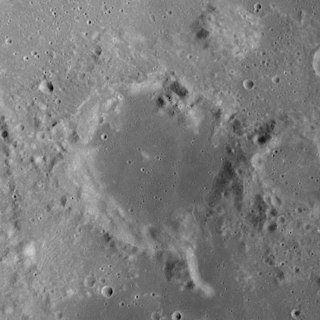
Maraldi is a worn, eroded crater on the western edge of the Sinus Amoris, in the northeast part of the Moon. To the west-southwest is the crater Vitruvius, and to the northwest lies the worn Littrow crater. Just to the northeast of the crater is the dome-like Mons Maraldi rise.
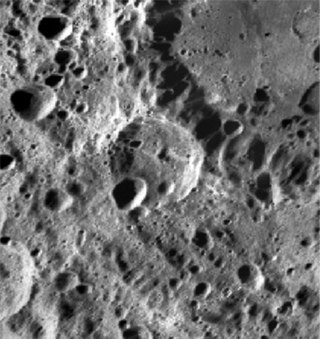
Belyaev is a lunar impact crater that is attached to the outer edge of the Mare Moscoviense, on the far side of the Moon. It is a worn formation with a small crater pair overlaying the southern rim, and several smaller craters across the relatively irregular interior.
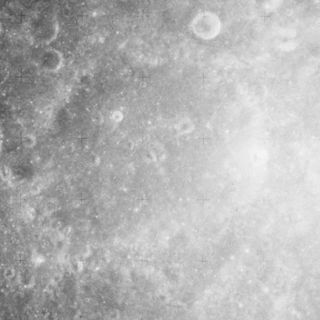
Buisson is a lunar impact crater that is located on the far side of the Moon. It is named after the French physicist Henri Buisson. Nearly attached to the southeast rim is the crater Vesalius. To the southwest is Einthoven. The rim of this crater is somewhat worn, and is lowest in the north. There is a low central ridge across the midpoint.
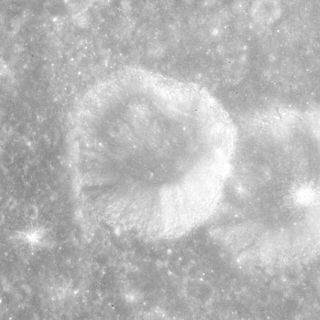
Daly is a small lunar impact crater that is located in the eastern part of the Moon, to the northwest of the crater Apollonius. This formation is relatively circular, with a slight inward bulge along the northern rim. The inner wall is wider in the southern half than in the north. The crater intrudes into the comparably sized crater Apollonius F to the east-southeast.

Elmer is a small lunar impact crater that is located to the south of Mare Smythii, near the eastern limb of the Moon. This crater is seen at a highly oblique angle from Earth, and the visibility is affected by libration. Elmer lies southwest of the crater Kreiken, and east-southeast of the larger Dale. This is a circular, bowl-shaped crater with an interior floor that occupies about half the total diameter.

Courtney is a tiny lunar impact crater on the Mare Imbrium, a lunar mare in the northwest quadrant of the Moon. It lies about two crater diameters to the northwest of Euler, in an otherwise isolated stretch of the mare. The dark surface in this region is marked by Euler's ray material. The name is an English male name.

Robert is a tiny lunar impact crater in the southeastern part of the Mare Serenitatis. It is located to the northeast of the small crater Dawes, and to the west of the Montes Taurus range. To the east-northeast of this position is the landing site of the Apollo 17 mission, in the Taurus–Littrow valley.

Fox is a small lunar impact crater on the far side of the Moon. It is named after the American astronomer Philip Fox. It lies near the northern rim of the crater Wyld, and to the southeast of Babcock. This crater is bowl-shaped, with a roughly circular rim, simple sloping walls and a relatively level, featureless interior. There is some talus along the northern inner wall.

Stella is a small lunar impact crater on the eastern side of Mare Serenitatis. It is a fresh crater with a prominent bright ray system. It is to the southwest of the larger Ching-Te, and west of the Taurus-Littrow valley where Apollo 17 landed in 1972.

Jerik is a tiny lunar impact crater in the southeastern part of the Mare Serenitatis. It is located to the northeast of the small crater Dawes, and to the west of the Montes Taurus range. To the east-northeast of this position is the landing site of the Apollo 17 mission, in the Taurus–Littrow valley.
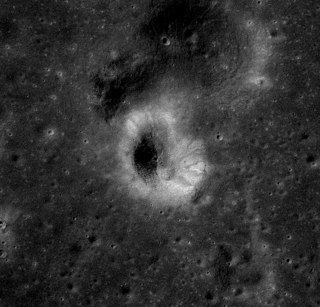
Mary is a tiny lunar impact crater in the southeastern part of the Mare Serenitatis. It is located to the northeast of the small crater Dawes, and to the west of the Montes Taurus range. To the east-northeast of this position is the landing site of the Apollo 17 mission, in the Taurus–Littrow valley.
























